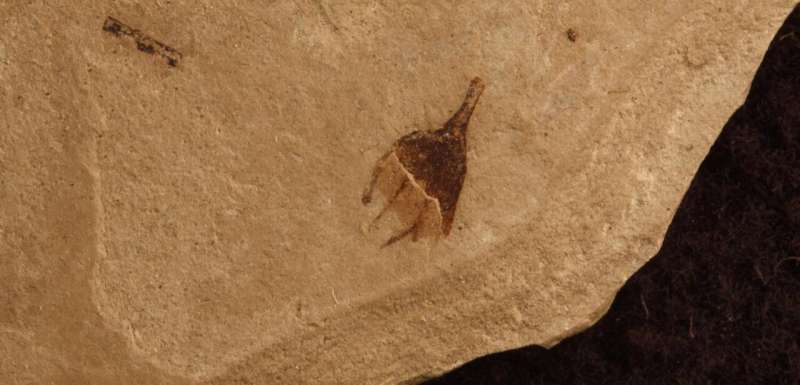This article has been reviewed according to Science X's editorial process and policies. Editors have highlighted the following attributes while ensuring the content's credibility:
fact-checked
peer-reviewed publication
trusted source
proofread
How forgotten Colorado fossils may rewrite part of plant evolutionary history

Botanists and paleontologists, led by researchers from CU Boulder, have identified a fossil chili pepper that may rewrite the geography and evolutionary timeline of the tomato plant family.
The team's findings, published last month in the journal New Phytologist, show that the chili pepper tribe (Capsiceae) within the tomato—nightshade (Solanaceae)—family is much older and was much more widespread than previously thought. Scientists previously believed that chili peppers evolved in South America at most 15 million years ago, but new research pushes that date to at least 50 million years ago—and suggests that chili peppers were in fact present in North America at that time.
Rocío Deanna, a postdoctoral researcher in ecology and evolutionary biology, and Abel Campos, an undergraduate double majoring in evolutionary biology and molecular, cellular and developmental biology, weren't planning to rewrite history when they met up one afternoon at the CU Boulder Museum of Natural History in 2021. Yet among a group of specimens in its collections gathered from the Green River Formation—geological treasure trove in northwestern Colorado and southwestern Wyoming—Deanna spotted a specific, solanaceous trait embedded in one fossil: little spikes on the end of a fruiting stem.
"At first, I thought 'No way, this can't be true,'" said Deanna, lead author of the study. "But it was so characteristic of the chili pepper."
After they discovered two of these fossils in the CU Boulder collections, Deanna and Campos, a co-author of the study, found one more from the chili pepper tribe in collections at the Denver Museum of Nature and Science (DMNS). All three fossils are from the Green River Formation in Colorado: the CU specimens from Garfield County and the DMNS fossil from Rio Blanco County.
These chili pepper fossils from the Eocene geological epoch (34 to 56 million years ago) match the timeline of another nightshade fossil found in the Esmeraldas Formation in Colombia, revealing that the family was already distributed across all of the Americas by as early as 50 million years ago.
"The family is way older than we thought," said Deanna, also a faculty member at the National University of Cordoba.

A fruit-fossil history
The nightshade family comprises 3,000 species and almost 100 different genera, including chili peppers. The ancient chili pepper was technically a fruit—and a berry, at that. While tomatoes and peppers are commonly associated with vegetables, they have seeds on the inside, which officially categorizes them as fruits.
The researchers cannot be sure of the chili's exact shape or color, but it was probably on the smaller end compared to modern day chili peppers. Like its relatives, it could have been quite spicy, according to Deanna.
Deanna and Campos identified the fossil by the unique shape of its calyx teeth: spikes on the end of the fruiting stem that hold on to the pepper, like those that hold a gemstone in a ring.
"The world has maybe 300,000 plant species. The only plants with that kind of calyx is this group of 80 or 90 species," said Stacey Smith, senior author of the paper and associate professor of evolutionary biology at CU Boulder.
Paleontologists collected the CU Boulder fossil from the Green River Formation in the 1990s. But its exact identity remained a mystery for years, in part because there are only a handful of "solanologists," botanists who study the nightshade family, in the world. When Deanna found these Colorado-based fossils, she had just returned from a global search for tomato family seed fossil specimens, only to find some "just ripe for the picking" right on campus.
"A lot of discoveries happen decades after the specimens have been collected," said Smith. "Who knows how many other new fossil species are sitting in any of these museums? They're just waiting for the right eyes to look at them."
Trickle-down evolution
The chili peppers in these fossils grew during the Eocene, a geologic epoch that lasted from about 34 to 56 million years ago as the continents drifted toward their present positions. During this balmy time in Earth's history, carbon dioxide levels ranged between 700 and 900 parts per million (twice as high as they are today), and palm trees grew as far north as Alaska. Because little to no ice was present on Earth, sea level was as much as 500 feet higher than it is today.
Scientists had assumed that the origins of chili peppers began in South America roughly 10 to 15 million years ago, where they then dispersed over land and water to the other continents. While Colorado today is home to very few native nightshades and no chili peppers, this new discovery hints that a plethora of plants from the tomato plant family may have existed in North America 40 to 50 million years ago, which have since largely disappeared.
But how did these peppers first get to North America? It's now a case of "the chicken or the chili pepper?"
Experts have theorized that fruit-eating birds, which existed as early as 60 million years ago, may have carried seeds and plants around the world with them in their guts, stuck to their feathers or in the mud on their feet. But these birds also had to be eating something to fuel their journeys—and fleshy berries, or peppers, make the perfect fuel. Birds may have distributed peppers from continent to continent, but peppers may also have been crucial to the success of those same birds.
So the nightshade family could have easily started in North America instead of South America, then dispersed in the other direction—and with this discovery, scientists can no longer say for sure, said Smith.
"These chili peppers, a species that we thought arose in an evolutionary blink of an eye, have been around for a super long time," said Smith. "We're still coming to grips with this new timeline."
More information: Rocío Deanna et al, Fossil berries reveal global radiation of the nightshade family by the early Cenozoic, New Phytologist (2023). DOI: 10.1111/nph.18904
Journal information: New Phytologist
Provided by University of Colorado at Boulder



















